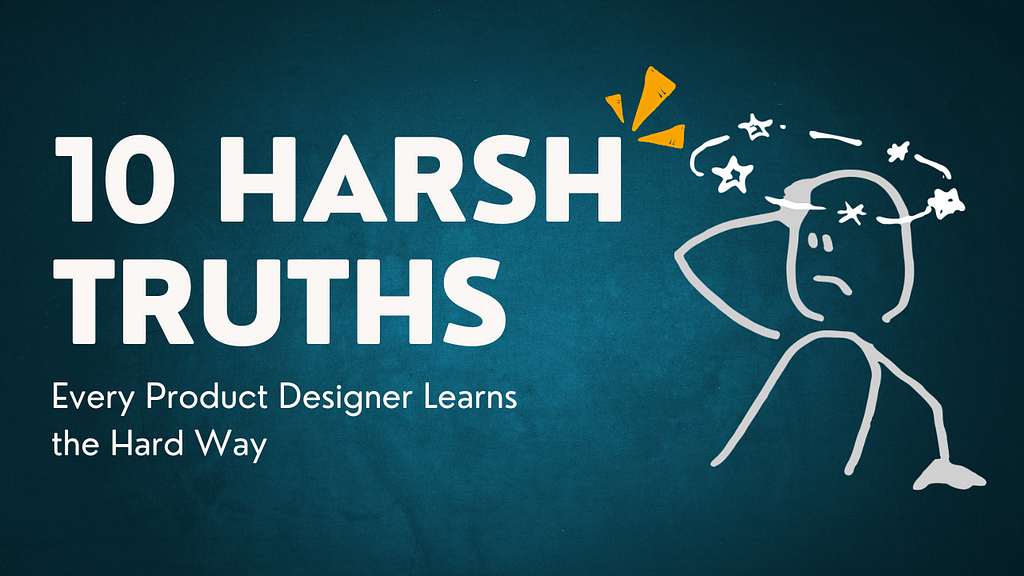
10 Hard Realities They Won’t Include in Job Postings
I was on cloud nine when I got my first job as a Product Designer.
Adobe xd launched. Headphones on. My trusty Spotify playlist playing and a folder full of UI inspiration at hand. I was ready to make magic happen, you know — stunning interfaces, silky smooth animations, actual user issues fixed with pixel-perfect precision.
But within weeks, the dream started to crack.
It wasn’t the work. It was the intangibles no one teaches you how to do:
endless meetings, vague requirements, design choices lost in translation, and the gut blow of seeing your work torn apart (sometimes unfairly).
And gradually, I realized that design is not all about getting things to look pretty.
It’s about working through chaos. Explaining the obvious. Compromising with grace. Taking the hits. Adapting at lightning speed. And still — somehow — believing in the work.
This post is my interpretation of the 10 tough realities I’ve learned — sometimes the hard way — as a working product designer.
If you’re a newbie to all of this or even if you’re a few years in, I hope these make you feel a little bit more seen, a little bit more ready, and a whole lot less alone.
1. Great Design Can Die in a Bad Meeting
You can have the best thought-out design in the universe — based on real data, edge cases sorted out, designed to the pixel…
But suppose the meeting that it’s being demonstrated in lacks direction, possesses an inattentive stakeholder, or an unexpected scope change?
Poof. It’s gone.
What did I learn? Don’t create the product only — create the story of your work. Your ability to speak up for yourself is as strong as your ability to make.
2. You Will Spend More Time Explaining Your Design Than Actually Making It
I used to think the job was: create, present, ship.
In real life, it’s: create, explain, clarify, revise, re-explain, align, re-align, then maybe ship.
That’s not a gripe — it’s a reminder. Good design is not just about design. Communication, patience, and repeatable storytelling are involved.
3. Developers Don’t Hate Designers — They Hate Vague Handoff
I used to believe devs were “anti-design” because they fought so hard against it.
As it turns out, they simply were tired of ambiguous specs, incomplete edge cases, or vague intent. When I began putting in contextual comments, accessibility guidelines, and improved documentation — our relationship improved.
Respect is mutual. Clarity breeds trust.
4. Users Are More Concerned with Solving Their Problem Than Your Visual Aesthetic
We are obsessed with font combinations and gradients.
But your user? They just want to book a cab, track an order, or fill a form without being stuck.
Design is not about happiness. It’s about usability.
The biggest compliment a user can give isn’t “this looks good” — it’s “this was easy.”
5. You’ll Design the Same Screen 10 Times — And That’s Okay
I would get angry as a child if I had to do something over.
Now I realize: every iteration taught me something.
That dropdown you reworked 4 times? Each iteration reduced friction. Each iteration made the experience easier.
Iteration is not failure. It’s refinement.
6. You’ll Learn to Distinguish Between Feedback and Your Identity
The very first time someone said, “This doesn’t work,” I didn’t feel like I worked.
But you develop a good detachment over time. Criticism is not about you, personally — it’s about the work. And sometimes the most difficult critiques are what help you change most rapidly.
Your work is not your character. Watch your craft, not your ego.
7. Good UI Won’t Save Bad UX You can’t lipstick a usability pig.
A clean UI can grab attention, but if users are lost in the middle or can’t find what they need — they’re gone.
The prettiest button in the world is useless if it does not go anywhere. Form should follow function.
8. Your Product Managers Will Reflect Your Strengths and Weaknesses
A PM is not your enemy. They’re your best ally.
If they don’t think you can fix things, they’ll micromanage the minutiae. But if you walk in with research, reason, and design thinking? They’ll sit back and let you drive.
How you operate determines how you are treated.
9. 80% solving problems, 20% pixels
This was the greatest change in attitude.
I previously believed my job was to get things to look good. In actuality, my job is to unravel things. Be it a flow that’s frustrating users or a process that’s bloated — you’re there to fix it.
And that begins long before the first screen appears.
10. Humility Makes Degrees Irrelevant
I’ve worked with “juniors” who asked better questions than “seniors.”.
I’ve encountered “leads” who are unable to articulate design intent and interns who blew minds.
The real benefits? They’re constantly learning, constantly improving, constantly listening. Growth is not in the name. It’s in your mind.
Final Thoughts
This article is not meant to frighten anyone off. It’s intended to give an accurate picture of what this work is really like — the sloppy, infuriating, gorgeous, rewarding world of product design.
If you are currently facing any of these barriers, understand this:
You’re not behind, you’re growing.
You’re not doing so bad. You’re getting better.
You’re not alone.
And if that spoke to you, pass it on. Someone somewhere is figuring this stuff out the hard way, just like we did.
Fun Fact: You can hold the clap button to give 50 claps. 😉
🚀 Enjoyed the read? I share more insights on product design, UI/UX, and building digital products every week.
👉 Follow me on LinkedIn for fresh posts and deep dives.
10 Harsh Truths Every Product Designer Learns the Hard Way was originally published in UX Planet on Medium, where people are continuing the conversation by highlighting and responding to this story.